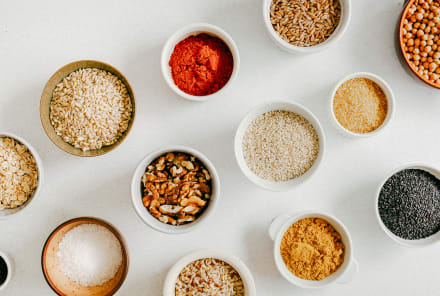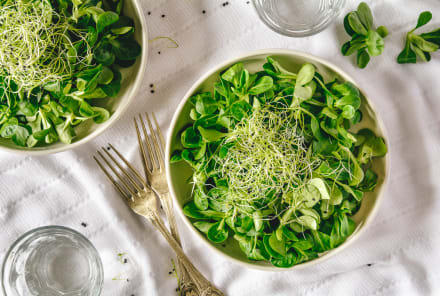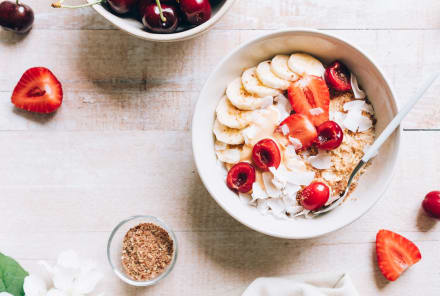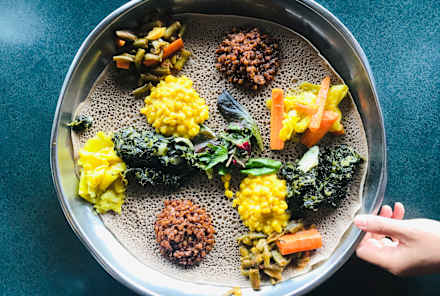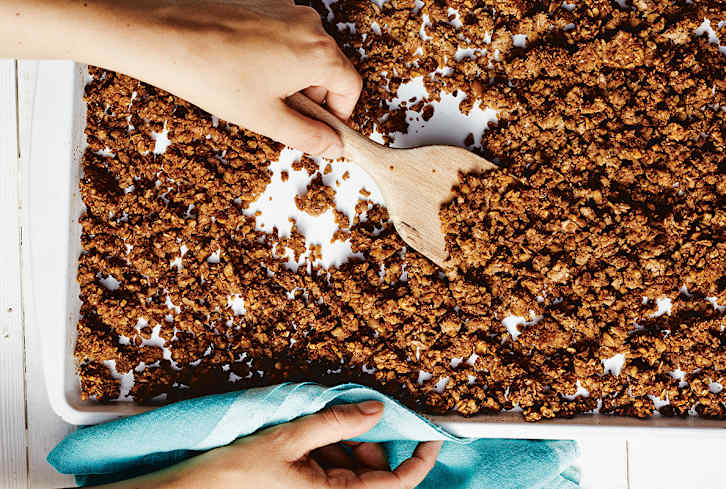Advertisement
A Beginner's Guide To The Kitchari Cleanse (Plus, A Recipe)

Sahara Rose is an author currently living in Los Angeles, California.

According to Ayurveda, true health stems from a balance between the mind, body, and spirit. We can achieve it by being intentional about the things we tell ourselves, the way we move our bodies, and, of course, the foods that we eat.
Kitchari is considered the ultimate healing meal in Ayurveda because it's simple, warming, and easy to digest. Here's what you need to know about the ins and outs of a kitchari cleanse, including how to make a basic kitchari recipe from scratch.
What to do (and what not to do) during a kitchari cleanse.
A kitchari cleanse calls for eating only kitchari—a meal of spiced rice and mung beans—for anywhere from three to 21 days. (If this is your first time undergoing a kitchari cleanse, it's better to limit the cleanse to no more than a week.) It can be done any time of the year for a quick reset, and I love doing it between seasons.
Why kitchari?
Kitchari has long been used in Ayurvedic detoxes because of its soothing impact on digestion.
Made of soaked mung dal (which is actually not a legume but rather a pulse and often very easy to digest even for those sensitive to legumes), rice, and spices, kitchari almost feels like food you would give a baby; it's extremely easy for the body to break down.
Eating only kitchari is a nice break from the hard-to-digest salads and smoothies that are popular these days. The soothing food is exactly what your body needs from time to time in order to cleanse, heal, and recover. You can keep eating kitchari even after the cleanse is complete, as it contains all three macronutrients—carbohydrates, fats, and proteins—to keep you nutritionally satisfied.
How and when to consume it.
Consuming kitchari two times a day is recommended during a cleanse.
Ayurveda suggests eating your largest meal around noon, when the sun is highest in the sky and your digestive fire (agni) is strongest. If you get up early in the morning, your breakfast can be your other meal, or if you stay up at night, you could eat your other meal for dinner.
The serving size is up to you, but Ayurveda suggests eating until your stomach feels two-thirds of the way full, and you feel satiated but not bloated. Eat until you get the feeling, "I could still eat, but I don't need to."
The most important thing is to listen to your body, observe how you feel, and act accordingly. While on this cleanse, it's better to eat only when you are truly hungry, not when you are frustrated or stressed, as this is also a way of healing your relationship with food.
What to drink when on a cleanse.
Try to steer clear of alcohol and coffee during your cleanse, since they are dehydrating. Instead, make herbal teas and elixirs—especially those containing ginger, turmeric, and ashwagandha—your best friends.
You can drink as much herbal tea as you like on your cleanse. In fact, an Ayurvedic test for dehydration is to take a sip of herbal tea or hot water every 20 minutes for a couple of days. If you notice that you start craving water every 20 minutes after this exercise, you are dehydrated (and should keep drinking!).
The key is frequency over quantity, so take small sips throughout the day to keep your digestive tract hydrated instead of gulping down a lot at once.
Should anyone avoid this cleanse?
Kitchari cleansing is considered safe because it consists of real, cooked food. However, if you are allergic/sensitive to any of the ingredients, have a history of disordered eating, or have been told to stick to a certain diet from your doctor, you should not engage in a kitchari cleanse.
How to reintroduce food after the cleanse.
After a kitchari cleanse, you can gradually reintroduce other cooked foods into your diet, such as quinoa, sweet potato, cooked vegetables, stews, curries, etc. Steer clear of raw, cold, and frozen, such as smoothies with frozen fruit or hard-to-digest kale salads for a few days since they will put your digestive system into overdrive. The key is to keep your food as easy to digest as possible.
The benefits of a kitchari cleanse.
In Ayurveda, proper digestion is a cornerstone of health. We all have an agni that—when in balance—can rev up digestion, help us adapt to changes in weather or seasons, and promote a calm, steady mind.
A kitchari cleanse helps balance your agni by promoting detoxification. So after undergoing a cleanse, you can expect to feel energized and clearheaded. You might also notice that your taste buds feel reset and you are able to recognize more flavors and feel more satisfied with the foods you eat.
Another benefit of this cleanse is that it can make you more aware of your eating tendencies. After streamlining your diet, you might realize that you have always been reaching for something sweet after meals, for example.
A basic kitchari recipe.
Ready to get started? This kitchari recipe, adapted from my book, Idiot's Guide to Ayurveda, is suitable for all three doshas: vata, pitta, and kapha. Ideally, you would make a fresh batch every day of the cleanse, but if you cannot for whatever reason (#life), you can definitely batch cook and keep it for one to three days in the fridge.
Ingredients:
- 3 tablespoons sesame oil (vata or kapha), coconut oil (pitta), or ghee (tridoshic)
- 1 teaspoon mustard seeds
- 1 teaspoon cumin seeds
- 1 cinnamon stick
- 6 cardamom pods
- 1 2-inch piece ginger, peeled and grated (2 tablespoons)
- ½ teaspoon turmeric
- ½ teaspoon sea salt
- 1 cup basmati rice, soaked overnight, drained, and rinsed
- 1 cup yellow split mung beans, soaked overnight, drained, and rinsed
- 8 cups water
- 2 pinches asafetida (optional)
- 1 or 2 pieces kombu kelp (optional)
- Juice of ½ lime (optional)
Method:
- In a large pot over medium heat, heat sesame oil. Add mustard seeds, and cook, shaking the pot occasionally, until you hear a popping sound.
- Add cumin seeds, cinnamon stick, cardamom pods, ginger, turmeric, asafetida (optional), and sea salt, and cook, stirring, for 30 seconds.
- Add basmati rice, mung beans, and kombu (optional), and cook, stirring, for about 1 minute to meld flavors.
- Add water and bring to a boil. Stir, reduce heat to simmer, cover, and cook for about 1 hour or until water is mostly absorbed and mixture has a creamy consistency similar to risotto.
- Remove from heat, add lime juice (optional), and serve.
Helpful tips for a cleanse.
To further balance your body during the kitchari cleanse and reap the full benefits, here are some more practices you can incorporate into your routine:
- Wake up at sunrise and go to sleep by sunset.
- Tongue scrape and oil pull.
- Drink hot water with ginger, cumin, cinnamon, coriander, and cardamom.
- Drink any tea of your choice or triphala tea for further cleansing.
- Practice meditation and yoga.
- Massage your body with warm sesame oil.
- Rest or take a walk in nature.
- Dry brush your body.
The bottom line.
Kitchari cleanses are very popular in Ayurvedic tradition. Eating the simple meal of rice, mung beans, and spices twice a day for three to 21 days is thought to enhance your digestive fire and support vibrant health.

Why Nutrition Is Key To Changing Your Relationship With Alcohol
Brooke Scheller, DCN, CNS

Why Alcohol Sabotages Your Gut Health & How To Get Back On Track
Brooke Scheller, DCN, CNS

Why Nutrition Is Key To Changing Your Relationship With Alcohol
Brooke Scheller, DCN, CNS

Why Alcohol Sabotages Your Gut Health & How To Get Back On Track
Brooke Scheller, DCN, CNS

Why Nutrition Is Key To Changing Your Relationship With Alcohol
Brooke Scheller, DCN, CNS

Why Alcohol Sabotages Your Gut Health & How To Get Back On Track
Brooke Scheller, DCN, CNS

Why Nutrition Is Key To Changing Your Relationship With Alcohol
Brooke Scheller, DCN, CNS

Why Alcohol Sabotages Your Gut Health & How To Get Back On Track
Brooke Scheller, DCN, CNS

